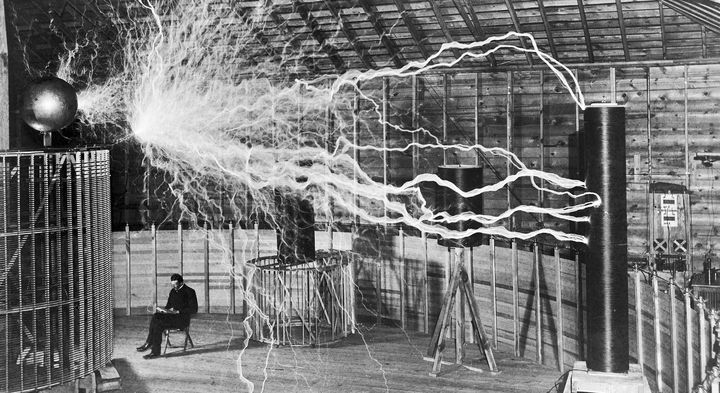Fallout from the Harvey Weinstein scandal has put the company in crisis—and destructive tremors have reached a 2017 Oscar hopeful. Following the horrifying expose of Weinstein’s behavior (longstanding and devastating in reach), the company announced that The Current War release would be pushed into 2018, leaving its future in doubt. Chris Evangelista, writing for FILM, aptly summarized the plight in an October 15th article, suggesting that only “time will only tell when The Current War sees the light of day.” In fact, time, and light, operate at the center of film’s story…and the more interesting history behind its script.
Benedict Cumberbatch of the widely acclaimed BBC SHERLOCK appeared in the film’s Toronto debut as Thomas Edison, the untouchable American inventor, at the height of his career and with the world on a string. Written by Michael Mitnick and directed by Alfonso Gomez-Rejon, the The Current War intends to offer a dazzling duel of electrical wizards, with Edison facing off to his greatest rival (and losing). But here we find a twist. The plot does not principally feature Edison’s row with the eccentric Tesla, as fans might expect, but instead a far more determined battle with George Westinghouse.
Westinghouse? You can almost hear the murmur from the balcony seats, possibly followed by rapid iPhone googling of the man whose company still competes with General Electric (GE). Westinghouse Electric Company, founded in 1886, today champions innovation you can be sure of—and it was George Westinghouse who toppled the Wizard of Menlo Park.
I discovered this often overlooked rivalry while researching a science of steampunk, CLOCKWORK FUTURES. The rabid, boisterous, highly charged history of electricity offers more fascination than the most daring fiction, and it starts further back than most people suppose. From Newton’s Royal Society demonstrations of the Hauksbee static machine to Michael Faraday’s electromagnetic field experiments, scientific minds sought to learn the radical properties of electric fire. Some of those experiments strike us today as prosaic or even comical (like the not-entirely-accurate account of Ben Franklin and his kite). Others, like Giovanni Aldini’s attempt at reanimating a corpse, haunt with the dread of Frankenstein…and in fact, probably inspired the young Mary Shelley, who witnessed Aldini’s “reanimation” of a corpse in a town square as a young girl.
But of all the misunderstood and twice-told tales of history, none so colorfully depicts heroism and villainy as the contest over AC versus DC current. In most of them, Edison plays the bully and villain, a shark stealing the ideas of others. Meanwhile, Tesla appears as an eccentric and misunderstood genius, taken advantage of by an American businessman. It’s excellent drama. It just isn’t particularly true. And at this moment, where we are facing up to the enormity of the Weinstein scandal, it pays to look at histories heroes and villains a bit more carefully.
Thomas Alva Edison was high profile, high rolling, full of good humor and, not infrequently, practical jokes at the expense of others. He ate pie as a regular meal, barked orders, solved problems, and made brazen claims. He sold over 1000 US patents, and in addition to his work on direct current and light bulbs, he aided in the invention and development of the phonograph and the motion picture camera. But his most astonishing invention actually lies with the method. Edison created the first industrial research laboratory—the first assembly line of inventive development where many hands did the work, but the patent remained with Edison. Unfair, you might think—except every present day company works just this way. Work for Google? Apple? Facebook? Coders and engineers develop innovations that will never bear their names. And it’s here that Mr. Edison and Mr. Tesla ultimately run afoul.
We have it on Tesla’s own evidence that he met Edison. The story offers a bit of revelation into both characters: A young Tesla asked Edison where he could get his shoes shined; Edison—a blue collar boy who had lifted himself by the bootstraps—thunders “you will shine the shoes yourself and like it!”[i] Used to preferential treatment, it was a comeuppance Tesla didn’t forget. Edison wasn’t planning to treat him (or his genius) any differently than the rest of his many workers. But Tesla was only too happy to point out just how exceptional his lofty mind really was; his autobiography spends most of its pages doing just that. When Tesla solved a problem for Edison, he therefore expected remuneration, but Edison took such problem solving in stride. That, after all, was Tesla’s job. The Current War trailer plays with just this fact—“I fix problems for idiots,” Tesla (Nicholas Hoult) rather begrudgingly admits. That didn’t keep him from trying to sell Edison on his ideas, of course; it did, however, keep Edison from buying them.
Edison refused Tesla’s ambitious ideas for a grid of alternating current on several grounds. In its natural state, current alternates; the electric charge reverses direction. Direct current could be produced only by using a sort of translator (a commutator) to force the current to flow one way—with power lost in the process. Tesla provided a means of producing consistent AC power, but in being so much stronger, AC was also much more dangerous. DC power worked just fine for Edison’s many patents and applications; he saw no need to take the risk.
George Westinghouse (played in the film by Michael Shannon) had no such reservations. He’d quadrupled his wealth in a single year, daring to engage Edison in legal battles over patents. When he was approached by Tesla, he saw an opportunity, albeit a risky one. Tesla, who was by no means as naïve as he is sometimes portrayed, asked a hefty fee and royalties for the adaptation of AC power. Equipped for battle, Westinghouse pit his own burgeoning company, run on AC power, against Edison Electric, ever a champion of DC. The biggest battles weren’t between men at all, but between companies.
Edison was not afraid to fight dirty. He would capitalized on the danger of Westinghouse’s AC current by promoting its use in the first electric chair. In 1890, the jerking, foaming body of a murderer named Kemmler brought back the image of reanimated corpse bodies, and nearly sunk Westinghouse’s reputation in turn. But Westinghouse still had the equally public-driven Tesla on his side; the inventor performed stunts of his own in support of AC’s “safe” use, including posing for hoax pictures in his lab with AC arcs of current dazzling about him. (It was, in fact, a double exposure. Tesla may have been eccentric, but he was no fool.) These blow-by-blow accounts certainly recapture the supposed battle of electrical genius, and it is often where the zing of fiction gets its material, but it tells but half the story. A few years before the Kemmler execution, Edison had in fact sold the business. General Electric subsumed Edison Electric, and while the battle carried on, it wasn’t Edison’s to fight. Tesla ultimately split from Westinghouse too, selling his patents for a lump sum in an 1897 patent sharing agreement… with GE. The rival companies had joined forces over a chance at bigger markets.
By the turn of the century, AC grids spanned across the nation, but the original “wizards” had long since moved on, just pawns in a much larger numbers game. In another twist, some recent biographies suggest that maybe, just maybe, Tesla and Edison never met face to face at all (or only very rarely), instead working through intermediaries. If true, then both men made their association more important to the public and press than it had been in reality. Perhaps they realized that the war of currents needed heroes and villains. Perhaps they, like us, knew a good script when they saw one.
So who won the battle of currents? Big business. Who wins them today? Frequently the same, accounting for the many ways a company can hide it’s dirty laundry to keep sales (and films) coming through. The current war of The Current War will be how to come back; will the film make it to market? I think it’s very likely. This battle and its key players continue larger than life. And it might be good to remember that, when Edison left the electricity business, he went on to invent the kinetograph…that is, the movie camera.

Tesla in his lab, double exposure photo
